Chapter 10D. Highway-Light Rail Transit Active Traffic Control Grade Crossing Systems
Section 10D.01 Introduction
Support:
Active light rail transit traffic control systems inform motorists,
bicyclists, and pedestrians of the approach or presence of light
rail transit vehicles at highway-light rail transit grade crossings.
These systems include four-quadrant gate systems, automatic gates,
flashing-light signals, traffic control signals, actuated blank-out
and variable message signs, and other active traffic control devices.
Guidance:
Where both traffic control signals and flashing-light signals (with
or without automatic gates) are in operation at the same highway-light
rail transit grade crossing, the operation of the devices should
be coordinated to avoid any display of conflicting signal indications.
If a pedestrian route is provided, sufficient clearance from supports, posts, and gate mechanisms should be maintained for pedestrian travel.
Option:
Audible devices may be operated in conjunction with the flashing
lights or traffic control signals.
Support:
Light rail transit typically operates through grade crossings in
semiexclusive and mixed-use alignments at speeds between 16 km/h
(10 mph) and 105 km/h (65 mph).
When light rail transit speed is cited in this Part, it refers to the maximum speed at which light rail transit vehicles are permitted to traverse a particular grade crossing.
Section 10D.02 Flashing-Light Signals
Support:
Sections 8D.02
and 8D.03
contain additional details regarding flashing-light signals.
Standard:
Highway-light rail transit grade crossings in semiexclusive alignments
shall be equipped with flashing-light signals where light rail transit
speeds exceed 60 km/h (35 mph). Flashing-light signals shall be
clearly visible to motorists, pedestrians, and bicyclists.
Guidance:
Where the crossing is at a location other than an intersection,
where light rail transit speeds exceed 40 km/h (25 mph), flashing
light signals should be installed.
Option:
Traffic control signals may be used instead of flashing-light signals
at highway-light rail transit grade crossings within highway-highway
intersections where light rail transit speeds do not exceed 60 km/h
(35 mph). Traffic control signals or flashing-light signals may
be used where the crossing is at a location other than an intersection,
where light rail transit speeds do not exceed 40 km/h (25 mph),
and when the roadway is a low-volume street where prevailing speeds
do not exceed 40 km/h (25 mph).
Section 10D.03 Automatic Gates
Support:
An automatic gate is a traffic control device used as an adjunct
to flashing-light signals. Section
8D.04 contains further details regarding automatic gates.
Guidance:
Highway-light rail transit grade crossings in semiexclusive alignments
should be equipped with automatic gates and flashing-light signals
(see Section 10D.02) where light rail transit speeds exceed 60 km/h
(35 mph).
Option:
Where the grade crossing is at a location other than an intersection,
where light rail transit speeds exceed 40 km/h (25 mph), automatic
gates and flashing-light signals may be installed.
Traffic control signals may be used instead of automatic gates at highway-light rail transit grade crossings within highway-highway intersections where light rail transit speeds do not exceed 60 km/h (35 mph). Traffic control signals or flashing-light signals without automatic gates may be used where the crossing is at a location other than an intersection and where light rail transit speeds do not exceed 40 km/h (25 mph) and the roadway is a low-volume street where prevailing speeds do not exceed 40 km/h (25 mph).
Automatic gates may be supplemented by cantilevered flashing-light signals (see Figure 8D-1) where there is a need for additional emphasis or better visibility.
The effectiveness of gates may be enhanced by the use of channelizing devices or raised median islands to discourage driving around lowered automatic gates.
Section 10D.04 Four-Quadrant Gate Systems
Option:
Four-Quadrant Gate systems may be installed to improve safety at
highway-light rail transit grade crossings based on an engineering
study when less restrictive measures, such as automatic gates and
channelization devices, are not effective.
Standard:
A Four-Quadrant Gate system shall consist of a series of automatic
gates used as an adjunct to flashing-light signals to control traffic
on all lanes entering and exiting the highwaylight rail transit
grade crossing.
The Four-Quadrant Gate system shall consist of a drive mechanism and fully retroreflectorized red- and white-striped gate arms with lights, and which in the down position extends individually across the entrance and exit lanes of highway traffic as shown in Figure 8D-2. Standards contained in Section 10D.02 for flashing-light signals shall be followed for signal specifications, location, and clearance distances.
In the normal sequence of operation, unless constant warning time or other advanced system requires otherwise, the flashing-light signals and the lights on the gate arms (in their normal upright positions) shall be activated immediately upon detection of the approaching light rail transit vehicle. The gate arms for the entrance lanes of traffic shall start their downward motion not less than 3 seconds after the flashing-light signals start to operate and shall reach their horizontal position at least 5 seconds before the arrival of the light rail transit vehicle. Exit gate arm activation and downward motion shall be based on timing requirements established by an engineering study of the individual site. The gate arms shall remain in the down position as long as the light rail transit vehicle occupies the highway-light rail transit crossing.
When the light rail transit vehicle clears the highway-light rail transit grade crossing, and if no other light rail transit vehicle is detected, the gate arms shall ascend to their upright positions, following which the flashing lights and the lights on the gate arms shall cease operation.
Gate arm design, colors, and lighting requirements shall be in accordance with the Standards contained in Section 8D.04.
Except as noted in the Option below, the exit gate arms shall be designed to fail-safe in the up position.
At locations where gate arms are offset a sufficient distance for vehicles to drive between the entrance and exit gate arms, median islands shall be installed in accordance with the needs established by an engineering study.
Guidance:
The gate arm should ascend to its upright position in not more than
12 seconds.
Four-Quadrant Gate systems should only be used in locations with constant-warning-time light rail transit vehicle detection.
The operating mode of the exit gates should be determined based upon an engineering study, with input from the affected transit agency.
If the Timed Exit Gate Operating Mode is used, the engineering study, with input from the affected transit agency, should also determine the Exit Gate Clearance Time.
If the Dynamic Exit Gate Operating Mode is used, vehicle intrusion detection devices should be installed to control exit gate operation based on vehicle presence within the minimum track clearance distance.
Regardless of which exit gate operating mode is used, the Exit Gate Clearance Time (see Section 8A.01) should be considered when determining additional time requirements for the Minimum Warning Time.
If a Four-Quadrant Gate system is used at a location that is adjacent to an intersection that could cause vehicles to queue within the minimum track clearance distance, the Dynamic Exit Gate Operating Mode should be used unless an engineering study indicates otherwise.
If a Four-Quadrant Gate system is interconnected with a highway traffic signal, backup or standby power should be considered for the highway traffic signal. Also, circuitry should be installed to prevent the highway traffic signal from leaving the track clearance green interval until all of the gates are lowered.
At locations where sufficient space is available, exit gates should be set back from the track a distance that provides a safety zone long enough to accommodate at least one design vehicle between the exit gate and the nearest rail.
Four-Quadrant Gate systems should include remote health (status) monitoring capable of automatically notifying light rail transit signal maintenance personnel when anomalies have occurred within the system.
Option:
Exit gate arms may fail in the down position if the highway-light
rail transit grade crossing is equipped with remote health (status)
monitoring.
Four-Quadrant Gate system installations may include median islands between opposing lanes on an approach to a highway-light rail transit grade crossing.
Guidance:
Where sufficient space is available, median islands should be at
least 18 m (60 ft) in length.
Section 10D.05 Traffic Control Signals
Support:
There are two types of traffic control signals for controlling vehicular
and light rail transit movements at interfaces of the two modes.
The first is the standard traffic control signal described in Part
4, which is the focus of this section. The other type of signal
is referred to as a light rail transit signal and is discussed in
Section 10D.07.
Standard:
The provisions of Parts 4 and 8
relating to traffic control signal design, installation, and operation,
including interconnection with nearby automatic gates or flashing-light
signals, shall be applicable as appropriate where traffic control
signals are used at highway-light rail transit grade crossings.
Guidance:
When a highway-light rail transit grade crossing equipped with a
flashing-light signal system is located within 60 m (200 ft) of
an intersection or midblock location controlled by a traffic control
signal, the traffic control signal should be provided with preemption
in accordance with Section
4D.13.
Coordination with the flashing-light signal system should be considered for traffic control signals located more than 60 m (200 ft) from the crossing. Factors to be considered should include traffic volumes, vehicle mix, vehicle and light rail transit approach speeds, frequency of light rail transit vehicles, and queue lengths.
If the highway traffic signal has emergency vehicle preemption capability, it should be coordinated with light rail transit operation.
Where light rail transit operates in a wide median, vehicles crossing the tracks and being controlled by both near and far side traffic signal faces should receive a protected left-turn green phase from the far side signal face to clear vehicles from the crossing when light rail transit vehicles are approaching the crossing.
Option:
Green indications may be provided during light rail transit phases
for vehicle, pedestrian, and bicycle movements that do not conflict
with light rail transit movements.
Traffic control signals may be installed in addition to four-quadrant gate systems and automatic gates at a highway-light rail transit crossing if the crossing occurs within a highway-highway intersection and if the traffic control signals meet the warrants described in Chapter 4C.
At a location other than an intersection, when light rail transit speeds are less than 40 km/h (25 mph), traffic control signals alone may be used to control road users at highway-light rail transit grade crossings only when justified by an engineering study.
Typical circumstances may include:
- Geometric conditions preclude the installation of highway-light rail transit grade crossing warning devices.
- Light rail transit vehicles share the same roadway with road users.
- Traffic control signals already exist.
Support:
See Section 4D.13
for considerations regarding traffic control signals at or near
highway-light rail transit grade crossings that are not equipped
with highway-light rail transit grade crossing warning devices.
Section 10D.06 Highway Traffic Signal Preemption Turning Restrictions
Guidance:
When a light rail transit grade crossing exists within a signalized
intersection, consideration should be given to providing separately
controlled Protected Only Mode turn phases for the movements crossing
the tracks (see Section
4A.02).
Standard:
Signal faces that are provided for separately controlled Protected
Only Mode turn movements toward the crossing shall display a red
indication during the approach and/or passage of light rail transit
vehicles.
Guidance:
When a signalized intersection that is located within 60 m (200
ft) of a highway-light rail transit grade crossing is preempted,
all existing turning movements toward the highway-light rail transit
grade crossing should be prohibited.
Support:
Part 4 contains information regarding signal phasing and timing
requirements.
Option:
An activated blank-out or changeable message sign and/or an appropriate
highway traffic signal display may be used to prohibit turning movements
toward the crossing during preemption (see Section
10C.09).
Standard:
Messages on the activated blank-out or changeable message signs
shall be visible only when the highway-light rail transit intersection
restriction is in effect.
Section 10D.07 Use of Traffic Control Signals for Control of Light Rail Transit Vehicles at Grade Crossings
Guidance:
Light rail transit movements in semiexclusive alignments at nongated
grade crossings that are equipped with traffic control signals should
be controlled by special light rail transit signal indications.
Support:
Examples of light rail transit traffic control signals, used to
control light rail transit movements only, are shown in Figure 10D-1.
Figure 10D-1 Examples of Light Rail Transit Signals
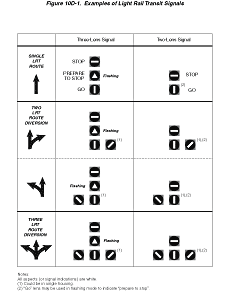
Option:
Standard traffic control signals may be used instead of light rail
transit traffic control signals to control the movement of light
rail transit vehicles (see Section 10D.05).
Standard:
If a separate set of standard traffic control signal indications
(red, yellow, and green circular and arrow indications) is used
to control light rail transit movements, the indications shall be
positioned so they are not visible to motorists, pedestrians, and
bicyclists (see Section
4D.17).
If the light rail transit crossing control is separate from the intersection control, the two shall be interconnected. The light rail phase shall not be terminated until after the light rail transit vehicle has cleared the crossing.
Option:
Light rail transit signals may be used at grade crossings and at
intersections in mixed-use alignments in conjunction with standard
traffic control signals where special light rail transit signal
phases are used to accommodate turning light rail transit vehicles
or where additional light rail transit clearance time is desirable.
Guidance:
Light rail transit signal faces should be separated vertically or
horizontally from the nearest highway traffic signal face for the
same approach by at least 0.9 m (3 ft).
Section 10D.08 Pedestrian and Bicycle Signals and Crossings
Standard:
Pedestrian signals shall be in accordance with Section
4E.04.
Guidance:
Where light rail transit tracks are immediately adjacent to other
tracks or a road, pedestrian signalization should be designed to
avoid having pedestrians wait between sets of tracks or between
the tracks and the road. If adequate space exists for a pedestrian
refuge and is justified based on engineering judgment, additional
pedestrian signal indicators, signing, and detectors should be installed
(see Section 4E.08).
Flashing-light signals (see Figure 10D-2) with a Crossbuck (R15-1) sign should be installed at pedestrian and bicycle crossings where an engineering study has determined that the sight distance is not sufficient for pedestrians and bicyclists to complete their crossing prior to the arrival of the light rail transit vehicle at the crossing, or where light rail transit speeds exceed 60 km/h (35 mph).
If an engineering study shows that flashing-light signals alone would not provide sufficient notice of an approaching light rail transit vehicle, the LOOK (R15-8) sign (see Figure 10D-2) and/or pedestrian gates should be considered (see Figures 10D-3, 10D-4, and 10D-5).
Figure 10D-2 Example of Light Rail Transit Flashing-Light Signal Assembly for Pedestrian Crossings
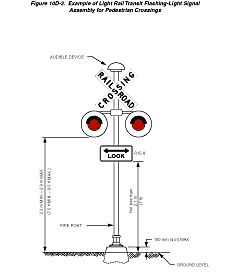
Figure 10D-3 Example of Pedestrian Gate Placement Behind the Sidewalk
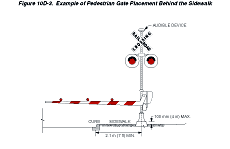
Figure 10D-4 Example of Pedestrian Gate Placement with Pedestrian Gate Arm
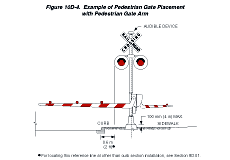
Figure 10D-5 Examples of Placement of Pedestrian Gates
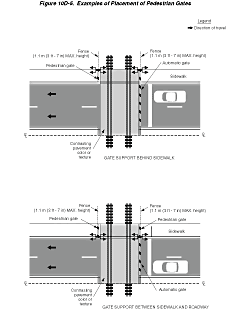
Support:
A pedestrian gate is similar to an automatic gate except the gate
arm is shorter.
The swing gate alerts pedestrians to the light rail transit tracks that are to be crossed. Swing gates are designed to open away from the tracks, requiring users to pull the gate open to cross, but permitting a quick exit from the trackway, and to automatically close.
Option:
Swing gates may be installed across pedestrian and bicycle walkways
(see Figure 10D-6).
Figure 10D-6 Example of Swing Gates

Pedestrian barriers at offset crossings may be used at pedestrian and bicycle crossings as passive devices that force users to face approaching light rail transit before entering the trackway (see Figures 10D-7 and 10D-8).
Figure 10D-7 Example of Pedestrian Barriers at an Offset Highway-Light Rail Transit Crossing
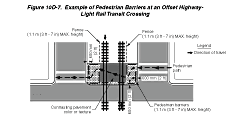
Figure 10D-8 Examples of Pedestrian Barrier Installation at an Offset Nonintersection Light Rail Transit Crossing

